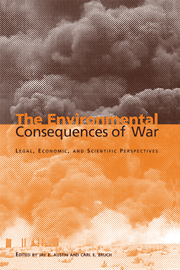Book contents
- Frontmatter
- Contents
- List of illustrations
- List of tables
- List of contributors
- Acknowledgements
- Foreword by Klaus Toepfer
- Introduction
- Part I General principles
- Introduction
- 1 The environment in wartime: an overview
- Part II The legal framework
- Part III Assessing the impacts – scientific methods and issues
- Part IV Valuing the impacts – economic methods and issues
- Part V Prospects for the future
- Index
Introduction
Published online by Cambridge University Press: 04 August 2010
- Frontmatter
- Contents
- List of illustrations
- List of tables
- List of contributors
- Acknowledgements
- Foreword by Klaus Toepfer
- Introduction
- Part I General principles
- Introduction
- 1 The environment in wartime: an overview
- Part II The legal framework
- Part III Assessing the impacts – scientific methods and issues
- Part IV Valuing the impacts – economic methods and issues
- Part V Prospects for the future
- Index
Summary
For as long as war has devastated the environment, moral and religious codes have sought to prevent or minimize the environmental impacts of wartime actions. Even in biblical times, Deuteronomy commanded:
When you are at war, and lay siege to a city for a long time in order to take it, do not destroy its trees by taking the axe to them, for they provide you with food; you shall not cut them down. The trees of the field are not men that you should besiege them. But you may destroy or cut down any trees that you know do not yield food, and use them in siege-works against the city that is at war with you, until it falls.
Although this is an anthropocentric perspective, applying only to the extent that environmental damage clearly harms society, it has been the basis for much of the Judeo-Christian scholarship in the area, including the development of the principle of bal tashchit, a rabbinical interpretation enjoining environmental waste and destruction.
Similarly, the Qur'an enjoins Muslims from harming trees in a jihad, a Muslim holy war. In fact, some Muslim armies included an officer who had the specific duty to ensure that “trees are not burnt, nor unjustifiably pulled out and that women, children, the elderly and unoffending priests or monks should not be harmed. He also ascertains that water and medicine are given to the prisoners of war.”
- Type
- Chapter
- Information
- The Environmental Consequences of WarLegal, Economic, and Scientific Perspectives, pp. 13 - 15Publisher: Cambridge University PressPrint publication year: 2000

